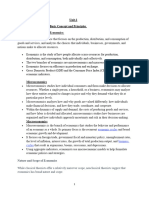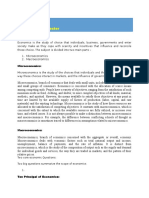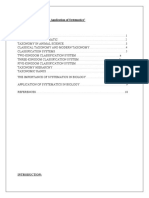Microeconomics
Microeconomics
Uploaded by
Margie Ballesteros ManzanoCopyright:
Available Formats
Microeconomics
Microeconomics
Uploaded by
Margie Ballesteros ManzanoOriginal Description:
Copyright
Available Formats
Share this document
Did you find this document useful?
Is this content inappropriate?
Copyright:
Available Formats
Microeconomics
Microeconomics
Uploaded by
Margie Ballesteros ManzanoCopyright:
Available Formats
MICROECONOMICS
Microeconomics (from Greek prefix mikro- meaning "small") is a branch of economics that
studies the behavior of individuals and firms in making decisions regarding the allocation
of limited resources. This is in contrast to macroeconomics, which involves "the sum total of
economic activity, dealing with the issues ofgrowth, inflation, and unemployment and with
national economic policies relating to these issues".[2] Microeconomics also deals with the
effects of national economic policies (such as changing taxation levels) on the aforementioned
aspects of the economy. Particularly in the wake of the Lucas critique, much of modern
macroeconomic theory has been built upon 'microfoundations'i.e. based upon basic
assumptions about micro-level behavior.One goal of microeconomics is to analyze the market
mechanisms that establish relative prices among goods and services and allocate limited
resources among alternative uses. Microeconomics also analyzes market failure, where
markets fail to produce efficient results, and describes the theoretical conditions needed
for perfect competition.
MACROECONOMICS
Macroeconomics is a branch of the economics field that studies how the aggregate economy
behaves. In macroeconomics, a variety of economy-wide phenomena is thoroughly examined
such as, inflation, price levels, rate of growth, national income, gross domestic product and
changes in unemployment.
Ang mikroekonomiks o mikroekonomiya (Ingles: microeconomics, Kastila: microeconoma;
nagmula sa Griyegong -: "maliit" o "munti"; at /ikonomia/: "ekonomiya") ay
isang sangay ng ekonomiyang nagsasagawa ng pag-aaral kung paano nagpapasya ang mga
tahanan at mga kompanya upang magamit at itatalaga ang limitado o kakaunting mga
kagamitan o yaman,[1] sa paraang tipikal at karaniwan sa loob ng
mga merkado o pamilihan kung saan mabibili at maipagbibili ang mabubuting mga dala-dalahin
o mga serbisyo. Sinusuri ng mikroekonomiya ang kung paano naaapektuhan ng ganitong mga
desisyon at asal, ugali, o gawi, ang pampuno at pangangailangan (supply and demand sa
Ingles) para sa mga mabubuting dala-dalahin at mga serbisyo, na nagiging batayan ng mga
presyo o halaga; at kung paanong ang presyo naman ay nagiging batayan ng pampuno at
pangangailangan ng mabubuting mga dala-dalahin at mga serbisyo.
Ang makroekonomiks o makroekonomiya (Ingles: macroeconomics, Kastila: macroeconoma
; mula sa unlaping "macr(o)-" na may kahulugang "malaki" + "ekonomiya") ay isang sangay
ng ekonomiyang humaharap sa galaw o pagsasakatuparan, kayarian o istruktura, at asal o ugali
ng isang pambansa o rehiyonal naekonomiya o kabuhayan bilang isang kabuuan.[1] Kasama
ng mikroekonomiya o mikroekonomiks, isa rin ang makroekonomiya sa dalawang pinaka
panglahatang mga larangan sa ekonomiya. Ito ang pag-aaral ng gawi o asal at pagpapasya ng
kabuoan ng mga ekonomiya.
You might also like
- Aramco Que - Civil InspectorDocument23 pagesAramco Que - Civil InspectorBasker Balu86% (7)
- Values 9 ModuleDocument4 pagesValues 9 ModuleFerin the EggNo ratings yet
- MacroeconomicsDocument1 pageMacroeconomicsfecitusNo ratings yet
- MicroeconomicsDocument9 pagesMicroeconomicsJohnfernando Abalos JuanNo ratings yet
- 1.0 Definition of Macroeconomic: Macroeconomics GDP Balance MicroeconomicsDocument4 pages1.0 Definition of Macroeconomic: Macroeconomics GDP Balance MicroeconomicsCrystal TanNo ratings yet
- Definition of 'Macroeconomics': What Is 'Microeconomics'Document1 pageDefinition of 'Macroeconomics': What Is 'Microeconomics'Hanna MeiNo ratings yet
- Microeconomics - Policy AnalysisDocument14 pagesMicroeconomics - Policy AnalysisGaudencio MembrereNo ratings yet
- Basics of MicroeconomicsDocument33 pagesBasics of MicroeconomicssaulmwakabanaNo ratings yet
- MICROECONOMIA Y MACROECONOMÍA - Est2018 - 1 PDFDocument2 pagesMICROECONOMIA Y MACROECONOMÍA - Est2018 - 1 PDFVanessa MayorgaNo ratings yet
- Economics NotesDocument13 pagesEconomics Notesbabydollhasina721No ratings yet
- What Is Microeconomics and How Does It WorkDocument1 pageWhat Is Microeconomics and How Does It WorkRandom AcNo ratings yet
- MicroeconomicsDocument33 pagesMicroeconomicsshamiah.muchesiaNo ratings yet
- Development of Modern Microeconomics Theory - AssignmentDocument8 pagesDevelopment of Modern Microeconomics Theory - AssignmentFetsum LakewNo ratings yet
- Economics Project Lina 12A PDFDocument2 pagesEconomics Project Lina 12A PDFlina atyaniNo ratings yet
- English PDFDocument8 pagesEnglish PDFzakizikouchelliNo ratings yet
- Economics: MicroeconomicsDocument3 pagesEconomics: MicroeconomicsTERENo ratings yet
- Nature and Scope of Macro Economic Issues: Unit IDocument38 pagesNature and Scope of Macro Economic Issues: Unit IVig NeshNo ratings yet
- Microeconomics Is The Social Science That Studies The ImplicationsDocument1 pageMicroeconomics Is The Social Science That Studies The ImplicationstareNo ratings yet
- Applied EconomicsDocument8 pagesApplied Economicsanup acharyaNo ratings yet
- H L Ahuja Book Chap. 1 - 2Document9 pagesH L Ahuja Book Chap. 1 - 2archana.rosuNo ratings yet
- MicroeconomicsDocument2 pagesMicroeconomicsparashNo ratings yet
- Foe Unit 1Document30 pagesFoe Unit 1Saravanan ShanmugamNo ratings yet
- Type in The Following Information Name: de La Torre, Noel E. Year Level: 3Rd Yr Course: Bs Crim. IrregDocument3 pagesType in The Following Information Name: de La Torre, Noel E. Year Level: 3Rd Yr Course: Bs Crim. IrregLeon Dela TorreNo ratings yet
- Health Eco-PrintDocument6 pagesHealth Eco-Printroxanne_amparoNo ratings yet
- Micro and Macro Economics.Document2 pagesMicro and Macro Economics.Yofin HmsiNo ratings yet
- Microeconomics Compilation of Reports Midterms Bsed SS2Document45 pagesMicroeconomics Compilation of Reports Midterms Bsed SS2Jack Daniel BalbuenaNo ratings yet
- Microeconomics (From Greek Prefix Mikro-Meaning "Small") Is A Branch ofDocument2 pagesMicroeconomics (From Greek Prefix Mikro-Meaning "Small") Is A Branch ofhimanshuNo ratings yet
- D2 EconomicsDocument23 pagesD2 EconomicsJane AlmanzorNo ratings yet
- What Is EconomicsDocument3 pagesWhat Is EconomicsKyle CastilNo ratings yet
- Question & AnswersDocument3 pagesQuestion & AnswersNikitha jain MNo ratings yet
- Micro-Economics 2nd Year 1st Semester: 1. Microeconomics 2. MacroeconomicsDocument2 pagesMicro-Economics 2nd Year 1st Semester: 1. Microeconomics 2. Macroeconomicsজয় সোমNo ratings yet
- Econ203 Lecture 1Document104 pagesEcon203 Lecture 1bilge100% (1)
- Untitled DocumentDocument10 pagesUntitled DocumentjiaazworkNo ratings yet
- Agricultural Economics NotesDocument86 pagesAgricultural Economics NotesManohar PawarNo ratings yet
- 17041AA106 - Micro and Macro EconomicsDocument8 pages17041AA106 - Micro and Macro EconomicsvarshiniNo ratings yet
- Reviewer MicroeconomicsDocument7 pagesReviewer Microeconomicsgzyville630No ratings yet
- Concept of MicroeconomicsDocument3 pagesConcept of MicroeconomicsBalNo ratings yet
- Economic Ballb Unit 01Document8 pagesEconomic Ballb Unit 01Sourabh K100% (1)
- Economics Difference BetweenDocument11 pagesEconomics Difference Between2580 Soumil SinghNo ratings yet
- Eco 211 HandoutDocument62 pagesEco 211 HandoutHannah CokerNo ratings yet
- Supply and Demand Resources Microeconomics Firms Consumers Government Macroeconomics Inflation Unemployment Industrial Production GovernmentDocument13 pagesSupply and Demand Resources Microeconomics Firms Consumers Government Macroeconomics Inflation Unemployment Industrial Production GovernmentKathy DianeNo ratings yet
- Tourism EconomicsDocument50 pagesTourism EconomicsSameer DNo ratings yet
- Economics t1Document18 pagesEconomics t1GauravNo ratings yet
- Distinction Between Microeconomics and MacroeconomicsDocument2 pagesDistinction Between Microeconomics and MacroeconomicskehindeadeniyiNo ratings yet
- What Is The Definition of MacroeconomicsDocument1 pageWhat Is The Definition of MacroeconomicsRandom AcNo ratings yet
- Basic Concept of EconomicsDocument8 pagesBasic Concept of Economicsthess franciscoNo ratings yet
- Macroeconomics StudentsDocument2 pagesMacroeconomics StudentsГордей ПолищукNo ratings yet
- Unit 1Document12 pagesUnit 1soumyakushwaha28No ratings yet
- Microecnomics & MacroeconomicsDocument20 pagesMicroecnomics & MacroeconomicsShane Melody G. GetonzoNo ratings yet
- Chapter OneDocument9 pagesChapter OneNoorshikha NeupaneNo ratings yet
- GC03 - I-Economic ConceptsDocument18 pagesGC03 - I-Economic Conceptsswati chaturvediNo ratings yet
- Microeconomics (Notes)Document97 pagesMicroeconomics (Notes)Jimmi Khan100% (1)
- Business and Ethics Week 4Document30 pagesBusiness and Ethics Week 4Umer IrfanNo ratings yet
- Microeconomic AnalysisDocument2 pagesMicroeconomic AnalysisGasimovskyNo ratings yet
- LESSON 1 INTRODUCTION OF Basic MicroeconmicsDocument2 pagesLESSON 1 INTRODUCTION OF Basic MicroeconmicsLeziel YangaNo ratings yet
- Principles of Agricultural Economics 1Document87 pagesPrinciples of Agricultural Economics 1thedogchannel100No ratings yet
- Understanding Economics and The Overwiew of The EconomyDocument7 pagesUnderstanding Economics and The Overwiew of The EconomyKathkath PlacenteNo ratings yet
- Abegail Blanco Mm2-IDocument9 pagesAbegail Blanco Mm2-IAbegail BlancoNo ratings yet
- Macro and Micro EconomicsDocument10 pagesMacro and Micro Economicsdb619No ratings yet
- Microeconomics - WikipediaDocument14 pagesMicroeconomics - WikipediakamaalNo ratings yet
- Landmark University, Omu Aran College of Business and Social Sciences Department of Economics Course Code: Eco 211 Course Unit: 2Document5 pagesLandmark University, Omu Aran College of Business and Social Sciences Department of Economics Course Code: Eco 211 Course Unit: 2Hannah CokerNo ratings yet
- Principles of Economics: A Comprehensive Introduction to the Fundamental Concepts of Microeconomics and Macroeconomics: Modern Economics: Book Series for Beginners and ProfessionalsFrom EverandPrinciples of Economics: A Comprehensive Introduction to the Fundamental Concepts of Microeconomics and Macroeconomics: Modern Economics: Book Series for Beginners and ProfessionalsNo ratings yet
- Abs-Cbn CorporationDocument29 pagesAbs-Cbn CorporationMargie Ballesteros ManzanoNo ratings yet
- IDocument1 pageIMargie Ballesteros ManzanoNo ratings yet
- Republic of The PhilippinesDocument1 pageRepublic of The PhilippinesMargie Ballesteros Manzano100% (1)
- Aileen B TabunanDocument2 pagesAileen B TabunanMargie Ballesteros ManzanoNo ratings yet
- Arithmetic MeansDocument8 pagesArithmetic MeansMargie Ballesteros ManzanoNo ratings yet
- The Sum of The First N Terms of An Arithmetic Sequence Is Called An Arithmetic SeriesDocument2 pagesThe Sum of The First N Terms of An Arithmetic Sequence Is Called An Arithmetic SeriesMargie Ballesteros ManzanoNo ratings yet
- Adjectives - Docxwith UnderlineDocument2 pagesAdjectives - Docxwith UnderlineMargie Ballesteros ManzanoNo ratings yet
- Football Hand SignalsDocument7 pagesFootball Hand SignalsMargie Ballesteros ManzanoNo ratings yet
- Reyman A. Fernando: Career ObjectivesDocument2 pagesReyman A. Fernando: Career ObjectivesMargie Ballesteros ManzanoNo ratings yet
- 7 Kinds of Environmental PollutionDocument7 pages7 Kinds of Environmental PollutionMargie Ballesteros ManzanoNo ratings yet
- AdjectivesDocument4 pagesAdjectivesMargie Ballesteros Manzano100% (1)
- ST ND RD TH TH TH TH TH TH TH TH TH TH TH TH TH TH TH TH THDocument2 pagesST ND RD TH TH TH TH TH TH TH TH TH TH TH TH TH TH TH TH THMargie Ballesteros ManzanoNo ratings yet
- Stone CarvingDocument1 pageStone CarvingMargie Ballesteros ManzanoNo ratings yet
- Acid and BasesDocument10 pagesAcid and BasesMargie Ballesteros ManzanoNo ratings yet
- Homo Floresiensis: Year of Discovery: 2003history of DiscoveryDocument4 pagesHomo Floresiensis: Year of Discovery: 2003history of DiscoveryMargie Ballesteros ManzanoNo ratings yet
- Johanna Natividad Gervacio: ASDS. Academics, Instruction and DevelopmentDocument2 pagesJohanna Natividad Gervacio: ASDS. Academics, Instruction and DevelopmentMargie Ballesteros ManzanoNo ratings yet
- To Achieve My Goals When I Work HardDocument2 pagesTo Achieve My Goals When I Work HardMargie Ballesteros ManzanoNo ratings yet
- Dance StepsDocument4 pagesDance StepsMargie Ballesteros ManzanoNo ratings yet
- A Brief History of The InternetDocument1 pageA Brief History of The InternetMargie Ballesteros Manzano0% (1)
- KP and The Genie PreviewDocument32 pagesKP and The Genie PreviewcrackerfundaNo ratings yet
- The Good MorrowDocument12 pagesThe Good Morrowfalak100% (1)
- Introduction To Technical WritingDocument33 pagesIntroduction To Technical WritingJaremiahNo ratings yet
- Critical Analysis of A Spanish Lover by Joanna TrollopeDocument4 pagesCritical Analysis of A Spanish Lover by Joanna TrollopemmvrochaNo ratings yet
- Instant download The Russian Revolution 1917 3rd Edition Rex A. Wade pdf all chapterDocument62 pagesInstant download The Russian Revolution 1917 3rd Edition Rex A. Wade pdf all chaptermermexareyz100% (1)
- Introduction of Dispensing PharmacyDocument21 pagesIntroduction of Dispensing PharmacyAina Butt100% (8)
- MATLAB Code For Amplitude ModulationDocument2 pagesMATLAB Code For Amplitude ModulationKazi Barakat50% (2)
- Interpreting Measures of PositionDocument13 pagesInterpreting Measures of PositionKristine HensonNo ratings yet
- GENERAL DIRECTIONS: READ, ANALYZE, and ANSWER The 45-Item Multiple ChoiceDocument8 pagesGENERAL DIRECTIONS: READ, ANALYZE, and ANSWER The 45-Item Multiple ChoiceAllenmay LagorasNo ratings yet
- Kanarev Water EnergyDocument11 pagesKanarev Water EnergyharishkumarsinghNo ratings yet
- Bathala.: 2. DumanganDocument4 pagesBathala.: 2. DumanganShinya KogamiNo ratings yet
- A.jjeb.s.6 Cre Paper 1Document2 pagesA.jjeb.s.6 Cre Paper 1gimbodaphine24No ratings yet
- Judicial Review 44Document118 pagesJudicial Review 44Hafiz Farrukh IshaqNo ratings yet
- Fins2624 Problem Set 5 Tutorial QuestionDocument5 pagesFins2624 Problem Set 5 Tutorial QuestionPhebieon MukwenhaNo ratings yet
- Private - Files - EAPP Module 1 ENGLISH FOR ACADEMIC AND PROFESSIONAL PURPOSE Updated 1Document10 pagesPrivate - Files - EAPP Module 1 ENGLISH FOR ACADEMIC AND PROFESSIONAL PURPOSE Updated 1Angel Trisha De Leon50% (2)
- PCGG Vs PeñaDocument2 pagesPCGG Vs PeñaTaper Garcia100% (1)
- Document 3Document12 pagesDocument 3Sanaya ChaudharyNo ratings yet
- Nursing Education and Curriculum DevelopmentDocument9 pagesNursing Education and Curriculum DevelopmentbarrichabarrichooNo ratings yet
- Capuno v. Jaramillo DigestDocument1 pageCapuno v. Jaramillo DigestErika Bianca ParasNo ratings yet
- Economics and Optimization TechniquesDocument163 pagesEconomics and Optimization TechniquesKiran KuppaNo ratings yet
- QRG - Mri AbdomenDocument2 pagesQRG - Mri AbdomenKhairunNisaNo ratings yet
- Spanish Essays About FamilyDocument7 pagesSpanish Essays About Familyezmv3axt100% (2)
- Navigating The Future: The Synergy of AI and Workplace DynamicsDocument6 pagesNavigating The Future: The Synergy of AI and Workplace DynamicsInternational Journal of Innovative Science and Research TechnologyNo ratings yet
- Strata - Manual Rev 399 PDFDocument103 pagesStrata - Manual Rev 399 PDFmanuel landinNo ratings yet
- Separation of Overlapping Latent FingerprintsDocument9 pagesSeparation of Overlapping Latent FingerprintsIAEME PublicationNo ratings yet
- Rational Function, Rational Equation and Rational InequalityDocument4 pagesRational Function, Rational Equation and Rational InequalityAsh LeyNo ratings yet
- Vijay Singh & Anr Vs State of M.P On 25 March, 1947 PDFDocument4 pagesVijay Singh & Anr Vs State of M.P On 25 March, 1947 PDFSandeep Kumar VermaNo ratings yet
- The Philosophy and Theology in DostoievskiDocument19 pagesThe Philosophy and Theology in Dostoievskiadrian duarte diazNo ratings yet












































































































